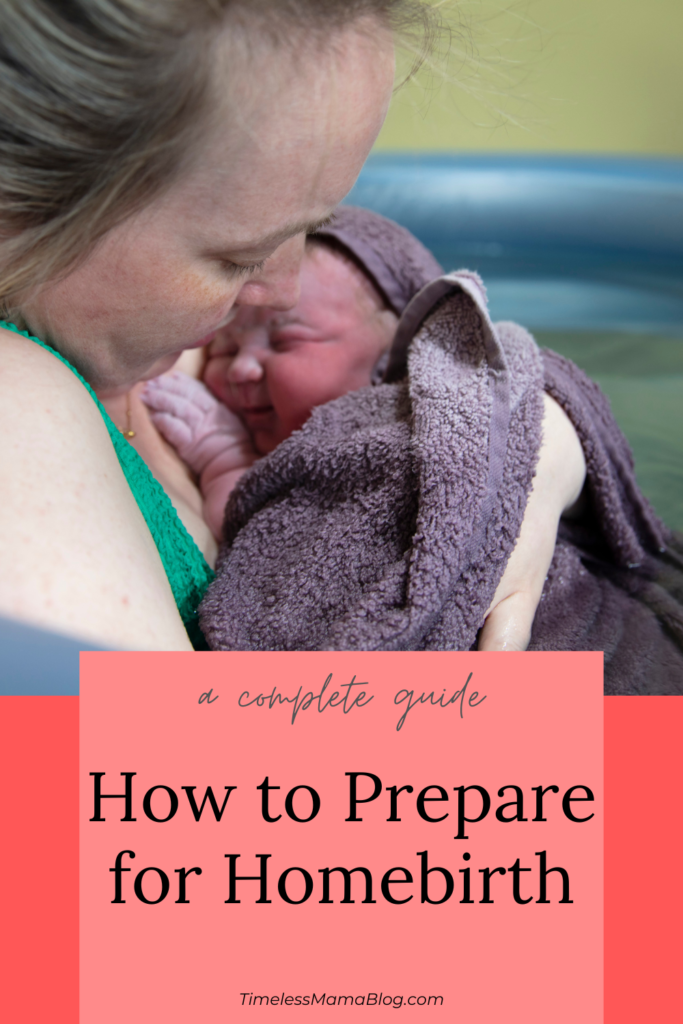{This post may contain affiliate links. That means that I earn a commission if you make a qualifyingpurchase through my links (such as Amazon), but it does not change the price that you pay. For more information, please see my disclaimer page.}
How I Prepare for Homebirth
Today I want to share how I prepare for homebirth, a bit about what is involved in preparing for a homebirth since that is the season I am in at the moment.
I do plan to share my birth stories from my 5 older children, as well as more about natural birth and homebirth specifically in the future, this is just what is on my mind right now.
Right now I am getting our home ready for our 6th baby, which will be our 5th homebirth. Over the years I have learned a lot about what I truly need during labor and in the immediate postpartum period.
My husband gets paternity leave for several weeks after the baby comes, so he will be on hand to take care of the children and do heat meals or make them if needed.

Preparing My For Labor
As with many things in life, taking time to prepare for homebirth is key. This starts with a foundational mindset, physical activity, as well as nutrition.
One of the biggest things for me is making sure that I am preparing my body, heart, and mind. Prayer for pregnancy, labor, and delivery is something that is big. I also reread Natural Childbirth the Bradley Way, Husband Coached Childbirth, Ina May’s Guide to Childbirth, and this time I am reading Earthley’s Birth Prep Guide. These help remind me of ways to prepare mentally as well as physically.
How to Mentally Prepare for Homebirth
Birth is very much a mental game. Because the more knowledgeable and confident you are about your body’s ability to birth and how birth works, the better. When you are informed ahead of time and have a can-do mindset, it makes a world of difference.
I know that a sign of transition is actually the feeling of “I can’t do this”. Because I can recognize that feeling as a sign of transition, I can give myself a mental pep talk reminding me that I am about to meet my baby. That I have, in fact, done this before and I AM capable of giving birth to this baby.
How to Physically Prepare for Birth
I use the Bradley Method of natural Childbirth and follow the Brewer Diet with a few tweaks.
The Bradley Method is largely about relaxing and allowing your body to work unhindered. You practice relaxing all of the muscles in your body and keeping your body in a relaxed state as it works to bring baby earthside. Instead of tensing up when waves or surges hit, you focus on relaxing your muscles.
Additionally, it recommends certain stretches/exercises to prepare your body for labor. A lot of these are part of the SLAM pregnancy program that I do, and the SLAM workout has some excellent stretches and pelvic floor workouts and relaxation. Keeping active during pregnancy keeps your stamina and muscle tone up. Use code TIMELESS on the website for a free 21 day trial.
Natural birth is very much like a marathon that takes physical and mental preparation. You do not just wake up one day and decide that you will run in today’s marathon. You will take time to train your body and mind for the challenge ahead. In the same way. preparing mentally and physically for birth is incredibly important.
The Brewer diet is about providing your body with the nutrients needed to make a healthy baby. I do modify it somewhat. We do not eat a lot of grains. I aim for 100-120 grams of protein instead of the 80. Most of our diet is very much based on the Weston A Price diet, which is very nutrient dense.
Preparing Food For Labor and Postpartum
I am preparing some really nutrient dense foods for my recovery that will be for mama specifically. I have made and frozen chicken and veg broths, some soups, livermush, egg cups, and I will be making chai lactation tea concentrate cubes this week and hopefully some meals for everyone, but it is vbs week, so it might just be the chai.
Meal planning and batch cooking and freezing meals is extremely helpful for postpartum recovery. I am sure that we will be blessed by church family with meals, but I like to have a stock of frozen things we can use just to make it easy.
While my home births have been rather short labors, having snacks and nutrient dense, easy to eat foods for mama and the midwives on hand is advised.
I usually keep a stash of protein and or granola bars on hand for the midwives, in a basket in the labor room.
For myself, cottage cheese, yogurt, honey sticks, nut butters, bananas, or avocado mash with a bit of lemon and salt mixed are my favorites. You don’t want anything you have to work too hard to consume. Chicken broth, orange juice, laborade, and coconut water are also on hand.
I have written more about how I prepare for postpartum here.
Children and Pets At Your Homebirth
If you have older children, or a pet you should make arrangements for care. They are some things to consider as you prepare for homebirth.
Pets
Talk to your midwife about having your pet present if you really want it, but some things to consider are that if they have not met the midwives, they may bark/become upset. They can also be very protective of you when you are giving birth and may protest strangers to them attending you. Labor sounds can also bother some dogs. Having someone your pet trusts to take them out if needed may be a good idea.
Children
We have our children present, with an adult on hand so that my husband can be my support person and in case we have to transfer to the hospital at any point during labor, or if they become overwhelmed they can step out with the adult.
I usually only worry about this with the youngest as all of the rest have been present at their other siblings’ births.
Several weeks before our due date we begin to remind the kids that mama will be pushing the baby out, and may make a lot of noise, but it’s okay.
We also watch homebirth videos on YouTube so they can kind of have an idea of what to expect.
There are some great children’s books on homebirth, and I plan to write a post with my favorite ways to prepare children for a homebirth.
Essential Oils For Birth
Safety First
I always have essential oils on hand. I am also big on safety when it comes to them. There are a lot of oils pregnant women are advised not to use until labor, and then oil should not be used around babies under 3 months to 2 years depending on the school of thought that you follow (and then only a very few are safe), so I do not usually diffuse oils during labor or for the first few months.
Your MLM’s promise of safety because of purity means nothing because the constituents that make the oils effective for what they are used for are still there and that is what makes certain oils unsafe for certain ages.
Instead I use an inhaler or cotton rounds with a couple of drops on them.
The Oils
Some oils to have on hand for labor and reasons they can be helpful (I’m not a medical doctor and these are not FDA approved uses, just things people have found *may* help with the following things):
- Lemon-Energy, mood, nausea
- Neroli-fear, tension, anxiety
- Copaiba-Calming, Pain
- Helichrysum-slowing after birth bleeding
- Clary Sage-Muscle tension, encourage labor/more effective contractions
- Lavender-Tension/anxiety, pain relief, relaxation
- Rose-circulation, labor pain management, relaxation
- Jasmine-mood, confidence, pain, strengthen contractions
- Frankincense-anxiety, pain relief
- Myrrh-Helps stalled labor, opening cervix
- Marjoram-soothing, afterbirth pain
- Peppermint-Nausea, mood, focus, energizing, pain relief, cooling
- Ylang-Ylang-Calming, encouraging, slow postpartum bleeding, postpartum uterine tone,
- Basil-Alertness, Anxiety, Focus, pain relief, pain endurance
- Black Pepper-mood, back labor, focus, anxiety, alertness, pain relief, pain endurance
- Geranium-uterine tone post birth and may slow postpartum bleeding, pain management
This is super important: DO NOT ADD OILS TO YOUR BIRTH POOL!
The Preparing My Homebirth Space
For my birth space, I chose our room, mainly because there’s room for the tub and our bed is right there. I have decorated it with fairy lights, and I have flameless candles that I turn on and water lights that I add to the pool in early labor. This gives the room a nice glow, while still supporting physiological birth in the dark.
I also have Scripture art around our room, and I am making a labor play list of Christian music.
The following supplies I have two four tiered carts for, one for the more birth related things, and one for postpartum and baby related things.
How to Prepare Your Bed for Homebirth
We start making our bed up especially for labor a week or so out from our due date, or at least when I start contracting. This is done with two old sheets in addition to two waterproof mattress covers. We layer them in the following order:
First, mattress cover, then sheet, after that another mattress cover, and finally sheet. This makes it so easy when the baby comes.
I usually give birth in a birth pool, then transfer to the bed to deliver the placenta, cut the cord, etc, We do have chucks pads all over the bed, but because we’ve prepare the bed this way, when I hop in the shower to clean up, the biggest part of the mess can be stripped off the bed easily and the next set is ready to go.
The Homebirth Supplies to Prepare
Now, I am getting ready to share what I usually have on hand for labor/delivery/postpartum, however each midwife will have her own list with more specifics (usually the more medical supply type things), so be sure to check with her.
While I have never had an issue with staining (thank you hydrogen peroxide!), you can definitely grab linens at the thrift store or use older ones that are on their last legs if you are really worried about it.
For a little more on these things, comments and thoughts, etc, check out the companion podcast episode.
My Basic Preparing for Homebirth Supply List
- Birth Homeopathy Kit
- Two water proof mattress covers
- Two older sheets
- 25+ chucks or underpads
- Exercise Ball (be sure to get one that is your size)
- Straws
- Water bottle with straw option
- Electrolyte powder (I use Earthley’s)
- Emesis Bags (barf bags)
- Hair Ties/Headbands
- A couple of labor gowns are nice to have on hand
- Lip Balm
- Snacks and drinks
- 4-6 towels
- 6 washcloths
- Hand held mirror
- Essential oils and inhalers/cotton rounds
- Placenta bowl
- Two 2 gallon ziptop bags
- Heating pad
- Fan
- Force of Nature Disinfectant
- Roll or two of paper towels
- 16 oz hydrogen peroxide
- 2 large black trash bags (39 gallon type)
Water Birth Supplies
- Tub (usually midwives will have several available for clients to use, some have an additional fee, or you can purchase one through Precious Arrows or In His Hands Birth Supplies)
- Waterbirth net
- Lead free food grade hose (25’ goes from our bathroom to where the tub will go easily, but be sure to check your space)
- Hose to sink or shower adapter (Be sure to test when you get it to make sure it is the right one and will work when you need it to)
- Shower filter
- Tub thermometer
- Additional 4-6 towels
- Tarp for under the tub (an old shower curtain often works as well if there’s a few feet around the tub on each side so your floor doesn’t get wet)
- Tub liner if renting a tub/pool
- Bathing suit for birth support
For Mama After Delivery
I have written a post on some more postpartum essentials that you can check out here, however these are some of the basics without explanation.
- Peri Bottle
- Ease the Ache by Earthley or AfterEase by Wishgarden
- Pain Potion by Earthley
- Calendula Tincture
- Arnica Gel, spray, and/or homeopathic pellets
- Herbal sitz bath (or herbs for peri bottle tea)
- Period panties
- Postpartum pads (I like HoneyPot and Nyssa or charcoal bamboo cloth diaper doublers with elastic on the sides)
- Feel Better Fast
- Mega Food Baby and Me Postnatal vitamins
- Desiccated beef liver pills and or Blood Vitality Pills
- Vitamin D cream
- Earthley Energy Plus
- Postpartum Balance
- Ease the Ache and After Ease Tinctures
- Immune Biotic
- Food to prepare first after birth meal (I am always super hungry after giving birth, and I love steak and eggs with some broth and orange juice)
For Baby and Breastfeeding
- New bulb syringe
- Measure tape for baby
- Receiving blankets
- Cord clamp or tie
- Baby hat (we don’t use hats and just do skin to skin)
- Homebirth certificate (not official-your midwives usually handle filling out the paperwork for the real one at the first postpartum visit)
- Ink Pad (birth suppliers hand a great one that doesn’t smear badly and cleans easily)
- Newborn Diapers
- Wipes
- Small bottle of avocado oil
- Baby clothes
- Burp Cloths
- Nose Frida
- Baby nail clippers
- Haakaa style breastpump
- Breastmilk bags
- Digital thermometer
- Carseat set up in car and ready to go in case of transfer
- Comfy postpartum clothes and pajamas I can nurse in
- My Brest Friend nursing pillow
- Lactation Massager (Best tool for helping with mastitis)
- Mother’s Herbal Mastitis Tincture
- Breastfeeding Supplies
To Pack or Not To Pack The Hospital Bag
Many people will pack a hospital bag “just in case”, however, I am not one to pack a hospital bag. I do set a bag near the supplies, and because of how I have them organized and set out they can easily be packed in minutes (while either transferring mom to the car, or waiting for an ambulance).
Conclusion on Preparing for Homebirth
In conclusions, preparing for homebirth can seem daunting, but broken down into steps it is actually quite easily.
I think above all, the biggest thing is mental preparation and knowledge of how your body is working to bring baby, even if you are planning a hospital birth.
Are You Planning a Homebirth? Did I share anything that you did not know before? How do you prepare for homebirth? What questions do you have about homebirth?
Related Posts






